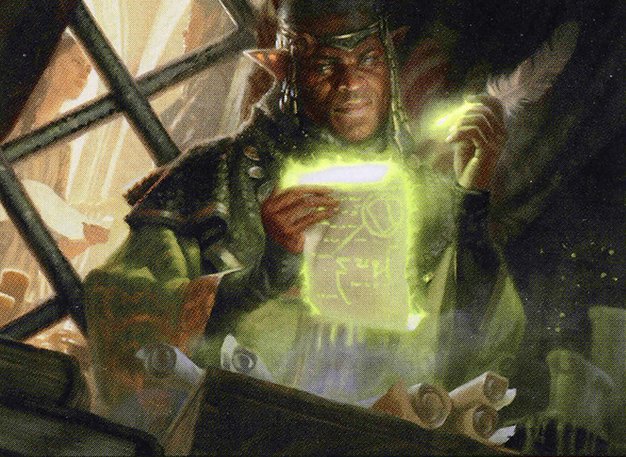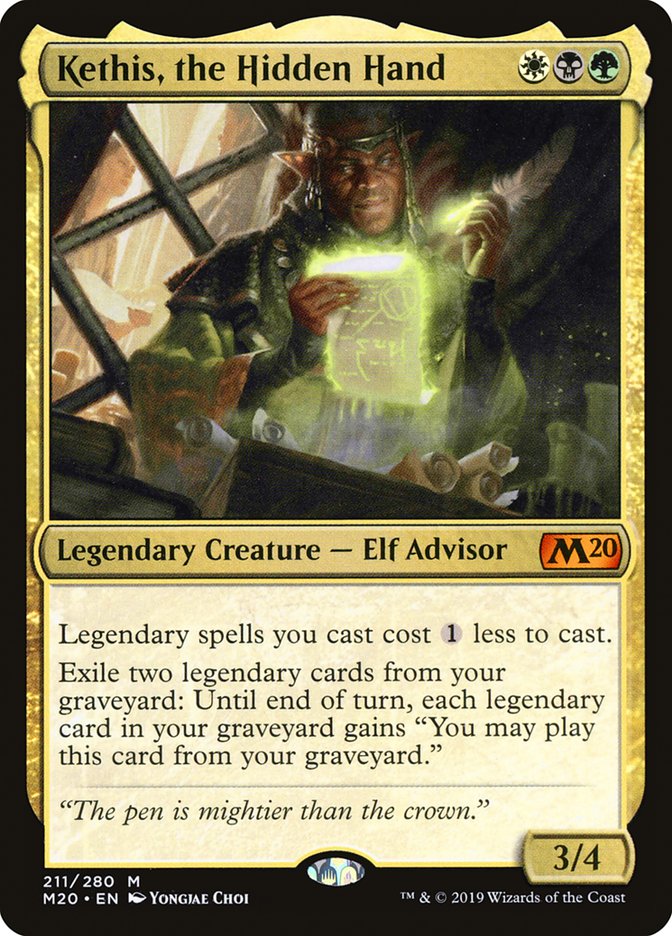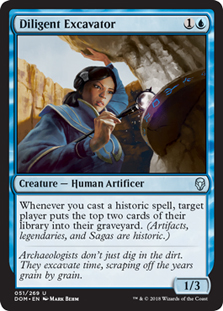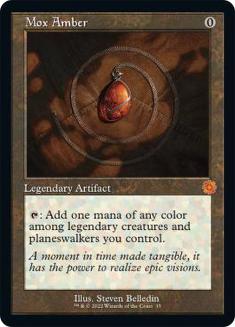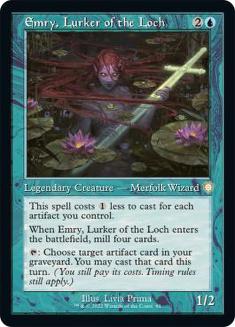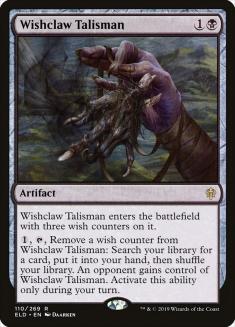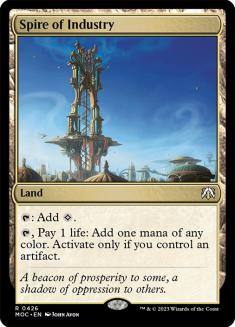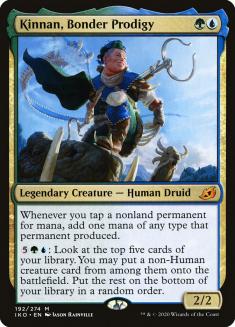Let’s just get the rant out of the way now…
I’m, to put it mildly, disappointed with yesterday’s ban announcement as it concerns Pioneer. It’s clear that the format is suffering since events aren’t reliably firing and the community holds a nearly universal negative opinion of it. Something needed to be done both for competitive balance and to create some excitement to entice players to return to a Constructed format that I still hold has the most potential to be great of any that exists right now.
I wrote about what I’d like to see done to reinvigorate Pioneer last week, and while the announcement of an impending Banned List change mere hours after that article went live made me briefly think I had some innate power to affect Wizards of the Coast’s (WotC) internal decision-making, the announcement itself left me wondering what exactly their plans are for such a promising format.
That said, getting back Oath of Nissa, while not flashy, is significant. Green decks dominated the format in its early days, and Oath has plenty of other applications as a cheap cantrip that helps to fix mana and can generate value with blink effects. So if we’ll have hope of dethroning the menace that is Dimir Inverter anytime soon, it’ll come from the space that Oath of Nissa opens up in the metagame.
For many, that will mean going back to a time when Turn 1 Elvish Mystic was one of the scariest openings in the format. Mono-Green Devotion is sure to get a shot in the arm given that Oath serves as a cheap source of devotion that helps find your Nykthos, Shrine to Nyx more consistently. I’m sure Todd Anderson will be attempting to relive his glory days of…eight months ago when he nearly ran the table in a Pioneer PTQ on Magic Online (MTGO), losing the finals to Simic Nexus after an undefeated run in the Swiss.
But I’m looking at something else. Though I am looking back to the same tournament, in fact at the deck Todd vanquished in the semifinals, Kethis Combo:
Creatures (19)
- 4 Hope of Ghirapur
- 4 Diligent Excavator
- 3 Lazav, the Multifarious
- 4 Kethis, the Hidden Hand
- 4 Emry, Lurker of the Loch
Planeswalkers (7)
Lands (20)
Spells (14)

Evaluating Combo Decks
When I look at combo decks, the three metrics by which I evaluate them are speed, resilience, and consistency. On the first two, Kethis scores very well. Its goldfish kills are around Turn 4, which is faster than Dimir Inverter and Mono-White Devotion and about on par with Lotus Breach, the premier combo deck in the current metagame.
To evaluate resilience, we want to look at a deck’s ability to directly resist disruption and to indirectly resist it by reloading with sources of card advantage. Kethis Combo is able to do both with maindeck Hope of Ghirapur and Teferi, Time Raveler serving the first role as Emry, Lurker of the Loch; Kethis, the Hidden Hand; and Teshar, Ancestor’s Apostle serve the second.
Graveyard hate can be problematic because your card advantage and combo both utilize that resource, which is why Evan used Oko, Thief of Crowns to good effect. It gave the deck an aggro gameplan that allowed it to ignore players who overloaded on hate. Oko may be gone, but this deck is still plenty resilient because of its natural card advantage and because its combo pieces are mostly creatures, so you have a built-in beatdown plan against slower decks.
The last metric, consistency, is where Kethis has faltered. The engine requires many pieces and a well-stocked graveyard, so finding those pieces quickly is important. Moreover, the deck has a very stretched manabase, playing four colors in a format without fetchlands. Oath of Nissa helps on both fronts as a cheap cantrip, and it explicitly makes your planeswalkers trivial to cast. The fact that it’s legendary itself means you’re not diluting the deck to play it like you would with something like Adventurous Impulse.
That combination puts Oath of Nissa over the top in this deck. The consistency boost it provides comes at essentially no cost in deck construction and helps the deck on the metric where it’s lacking the most.
Building a Kethis Deck
When it comes to building around Kethis, the Hidden Hand, the core cards remain the same from last fall:
With these three cards and a stocked graveyard, you can use Kethis to loop Mox Amber, eventually finding multiple copies to cast for each Kethis activation. Diligent Excavator then mills your deck, and the mana you float with Mox Amber eventually leads to casting Jace, Wielder of Mysteries. Importantly, with Oath of Nissa back, you won’t need a blue legend on the battlefield to get the mana to cast the Jace with Mox Amber, and Kethis with Mox gives you the green mana to cast an Oath from the graveyard.
Emry, Lurker of the Loch serves a key role supporting this core since it fills your graveyard efficiently, and rebuys Mox Amber to provide acceleration, and acts as a source of card advantage in long games. It’s not essential to the deck, but it does a great job of setting up the rest of what you’re doing.
Lurrus of the Dream-Den is the major addition from recent sets. It’s yet another way to generate card advantage from the graveyard, and it plays well with Mox Amber, Hope of Ghirapur, and the returning Oath of Nissa. Recasting a Diligent Excavator is particularly important, and there’s even an indirect way to get a Kethis from the graveyard by recasting Lazav, the Multifarious. There’s a stretch here for the mana but this deck already wanted to play an Urborg, Tomb of Yawgmoth or two to limit the damage done by Mana Confluence, and that goes a long way toward casting the powerful Cat.
With all of these factors in mind, I’ve developed two different lists for Kethis Combo in Pioneer. The first one is straightforward, playing all the good cards with no fluff:
Creatures (22)
- 4 Hope of Ghirapur
- 1 Teshar, Ancestor's Apostle
- 4 Diligent Excavator
- 3 Lazav, the Multifarious
- 4 Kethis, the Hidden Hand
- 4 Emry, Lurker of the Loch
- 2 Lurrus of the Dream-Den
Planeswalkers (6)
Lands (21)
Spells (11)

We’re playing four copies of each of our core cards here, along with four of our maindeck disruptive elements in Hope of Ghirapur and Teferi, Time Raveler. The supplementary cards all provide resilience via card advantage in various different ways. Terrarion works well with Lurrus and Emry while providing more mana fixing. Teshar can rebuild your battlefield from scratch after a sweeper. Tamiyo is excellent at filling your graveyard, at which point you can Regrow whatever piece of the engine you’re missing and go off.
And lastly we come to Wishclaw Talisman. There wasn’t room for it in Evan’s list because there were more powerful options, but it still works well in the deck. It’s another card to recast from the graveyard with Lurrus and Emry. It can function as a simple three-mana tutor. And most importantly it synergizes excellently with Teferi, Time Raveler. If on four mana you activate Talisman, find Teferi, and then bounce the Talisman back to your hand, you’ve set yourself up to combo soon after with protection from all manner of interaction.
The mana here is a work in progress that will have to be tuned via trial and error, but I like having one copy of Spire of Industry as a fifth rainbow land, as well as a high number of the green fastlands so you can cast Oath on Turn 1 reliably. The singleton Zagoth Triome is relatively low-cost since this deck doesn’t have a lot of one-mana plays, but it could easily be an Indatha Triome instead. I reasoned that with Oath covering white mana for Teferi, you’d rather lean toward having black for Lazav and your many black sideboard cards.
Looking at the sideboard, there are some nice gains from recent sets there as well. Mythos of Nethroi is your bread-and-butter answer to opposing hate cards like Rest in Peace and Damping Sphere, and its versatility is quite valuable here. The other bread-and-butter cards are Fatal Push and Thoughtseize, simply the best disruptive elements against aggro and combo/control decks available in the format.
The remaining sideboard cards are niche answers to common decks in the format. Narset, Parter of Veils disrupts Dimir Inverter and Lotus Breach, and with Oath of Nissa your noncreature count is higher. Kambal, Consul of Allocation and Oath of Kaya are excellent against burn, with Kambal pulling double duty against other combo decks. Soul-Guide Lantern provides graveyard hate that synergizes with Emry and Lurrus so you can bring it in even against decks that only tangentially use the graveyard and feel good about it.
Lastly, Urza’s Ruinous Blast is a great sweeper, but particularly excellent against Mono-White Devotion. With all of their enchantment-based removal, I have a hard time imagining how resolving one leaves you in anything but a significantly advantageous position, even if they have some permanents that survive it.
Getting Fancy with Kinnan
The second list I’ve devised is more experimental but has the potential to be very explosive. Many Kethis lists around recently play Springleaf Drum over Terrarion in the cheap artifact slot for some acceleration. With Lurrus and Emry I opted for the additional card advantage, but with Kinnan, Bonder Prodigy, you can opt to play both and generate a lot of extra mana:
Creatures (22)
- 2 Hope of Ghirapur
- 1 Teshar, Ancestor's Apostle
- 4 Diligent Excavator
- 2 Lazav, the Multifarious
- 4 Kethis, the Hidden Hand
- 4 Emry, Lurker of the Loch
- 2 Lurrus of the Dream-Den
- 3 Kinnan, Bonder Prodigy
Planeswalkers (4)
Lands (20)
Spells (14)

Doing so does come at a cost, since that mana engine takes a lot of space. Here I’ve cut way down on the maindeck disruption with only two copies of Hope of Ghirapur and three of Teferi, Time Raveler. But in return you get a significant return in speed and explosiveness. Kinnan already plays very well with Mox Amber. This list will generate a solid number of Turn 3 kills, and if the extra mana leads to flooding, Kinnan’s activated ability finds every combo piece save for Excavator.
With so many other decks in Pioneer threatening to end the game with combos of their own, this explosiveness is valuable, as oftentimes in combo mirrors you have to win the race. The first list is certainly safer, but if you’re looking for the highest potential, then Kinnan is it.
In Defense of Engine Combo
Right now, you may be saying to yourself, Ross, why should I be excited about another combo deck in Pioneer? Isn’t the prevalence of combo in the metagame the main problem with the format? But I think this view is overly simplistic and misguided.
There’s a fundamental difference between engine-based combo decks and ones that win with a specific two- or three-card set. The latter are wholly uninteresting with the exception of Splinter Twin in Modern, which was only interesting because it wasn’t a true combo deck. Dimir Inverter has that same dynamic but is so immensely frustrating because the combo is so difficult to interact with that it doesn’t matter.
Engine combo decks like Storm, Elves with Glimpse of Nature, and Kethis Combo are a completely different animal. They are as close to works of art as Magic gets, taking a mish-mash of individually unplayable cards and creating something beautiful from the morass. It takes much more effort to build a proper list of these decks than surrounding a two-card combo with a pile of disruption and card draw, so the emotional payoff when they work is much higher.
This doesn’t mean every engine combo deck creates fun experiences. There’s another factor here at play, and that’s offering many potential angles of attack for your opponents. Lotus Breach has proven powerful enough that only Damping Sphere is a true hate card. But against Kethis you can realistically use graveyard hate, creature removal, and tax effects like Damping Sphere to good effect. Eliminate in particular should prove very effective, since it answers the various combo pieces as well as Teferi, Time Raveler. Therefore, it won’t restrict metagame diversity in the same way.
I look at Kethis and I see both a powerful new strategy and one that can be good for the overall health and playability of the Pioneer metagame.

